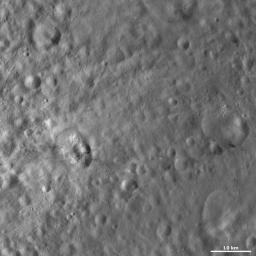Teia Crater
Caption:
This Dawn Framing Camera (FC) image of Vesta shows Teia crater, which is the crater with bright and dark material offset to the left of the center of the image. Teia crater is only 6.6 kilometers (4 miles) in diameter but it contains a lot of curious features. Firstly, it has an irregularly shaped rim, which is fresher on one side and partially obscured on the other side. The rim is partially obscured by what appears to be slumped material. There are boulders visible on the top of this slumped material. The boulders can be identified by the dark shadows that they cast and are only a few hundred meters (hundreds of feet) across. There is mostly bright material in Teia crater but there is also a patch of dark material on one side. An older, more degraded crater, on the bottom right side of Teia crater, is partially covered by Teia crater.
This image is located in Vesta's Numisia quadrangle, a few degrees below Vesta's equator. NASA's Dawn spacecraft obtained this image with its framing camera on Oct. 22, 2011. This image was taken through the camera's clear filter. The distance to the surface of Vesta is 700 kilometers (435 miles) and the image has a resolution of about 62 meters (203 feet) per pixel. This image was acquired during the HAMO (high-altitude mapping orbit) phase of the mission.
Background Info:
The Dawn mission to Vesta and Ceres is managed by NASA's Jet Propulsion Laboratory, a division of the California Institute of Technology in Pasadena, for NASA's Science Mission Directorate, Washington D.C. UCLA is responsible for overall Dawn mission science. The Dawn framing cameras have been developed and built under the leadership of the Max Planck Institute for Solar System Research, Katlenburg-Lindau, Germany, with significant contributions by DLR German Aerospace Center, Institute of Planetary Research, Berlin, and in coordination with the Institute of Computer and Communication Network Engineering, Braunschweig. The Framing Camera project is funded by the Max Planck Society, DLR, and NASA/JPL.
More information about Dawn is online at
http://www.nasa.gov/dawn
and
http://dawn.jpl.nasa.gov
.
Cataloging Keywords:
| Name |
Value |
Additional Values |
| Target |
4 Vesta |
|
| System |
Main Belt |
|
| Target Type |
Asteroid |
|
| Mission |
Dawn |
|
| Instrument Host |
Dawn |
|
| Host Type |
Orbiter |
|
| Instrument |
Framing Camera (FC) |
|
| Detector |
|
|
| Extra Keywords |
Crater, Grayscale, Shadow |
| Acquisition Date |
|
| Release Date |
2012-05-22 |
| Date in Caption |
2011-10-22 |
|
| Image Credit |
NASA/JPL-Caltech/UCLA/MPS/DLR/IDA |
| Source |
photojournal.jpl.nasa.gov/catalog/PIA15769 |
| Identifier |
PIA15769 |

 Planetary Data System
Planetary Data System
